
Jean-Marie Eveillard interviewed by Eric King of King World News about QE2 and it's effect on the Gold & Silver Market and much more......listen here


Spot gold hit a high of $1,387.10 an ounce and was bid at $1,382.75 an ounce at 0930 GMT (5:30 a.m. EDT), against $1,370.90 late on Wednesday. U.S. gold futures for December delivery were up $13.90 at $1,384.40, having peaked at $1,388.10 an ounce.
Gold prices have risen more than 25 percent this year as the dollar has been battered by expectations that U.S. policymakers will pursue an increasingly loose monetary policy involving quantitative easing to stimulate economic growth.
"If there is further dollar weakness surrounding quantitative easing and the like, it is almost certainly going to be highly supportive for gold," said RBS Global Banking & Markets analyst Daniel Major.
"We are very close to the $1,400 level, so if we get some more dollar weakness, I would not be surprised to see that in the near future," he added.
Silver prices also rode higher on gold's coat-tails, reaching a fresh 30-year high at $24.90 an ounce before easing back to $24.58 an ounce against $23.89.
The dollar index -- which measures the dollar's performance against a basket of six major currencies -- hit the year's low on Thursday after Singapore widened its currency's trading band, piling more pressure on to the struggling greenback.
Investors are continuing to dump the U.S. currency on expectations the Federal Reserve will start further money-printing next month, and as tensions rise over the increasing volatility of the foreign exchange markets.
"Although QE expectations are an important element of the rally, currency disputes are also a prime driver of gold prices," said HSBC's Jim Steel in a note. "The recent IMF meeting saw the public airing of sharp disagreements between China and the United States on currency policy."
"The EU has seconded U.S. calls for China to liberalize its exchange rate polices," he added. "Additionally, emerging market nations including Brazil, India, and Thailand have imposed taxes on capital inflows or sought to limit inflows, in an effort to stem currency appreciation."
While these tensions persist, gold is likely to be well supported, he said.
SPDR GOLD ETF SEES OUTFLOW
Swiss bank UBS raised its one-month forecast for gold to $1,425 an ounce from $1,300, saying it sees limited downside potential for gold ahead of the Fed's November meeting, and its three-month price view to $1,400 an ounce from $1,300.
"Gold's climb is not showing any signs of slowing," it said. "$1,400 is now being eyed as a short-term target, which seems easily achievable as long as the dollar continues to fall across the board."
Gold's rally toward $1,400 an ounce has outpaced most expectations. A poll conducted at the London Bullion Market Association's annual conference in September gave an average forecast for gold to be trading at $1,450 by September 2011.
A poll of 55 analysts conducted by Reuters in July returned an average price forecast of $1,197 an ounce for 2010. Interest in gold-backed exchange-traded funds remained soft, however, with holdings of the world's largest, New York's SPDR Gold Trust, declining further on Wednesday. They have fallen some 19.5 tonnes since the end of September. Among other precious metals, palladium rallied to a fresh 9-year high at $603 an ounce, lifted by strength in gold, dollar weakness and an improving supply and demand picture. Palladium was at $601 against $590.45, while platinum was at $1,713.55 an ounce against $1,702.25.
Anyone following the futures market for silver knows that the large commercial traders, banks such as JPM, always win. That is until now. Let's look at the history of short selling as it related to silver in the past, what has been occurring recently and what may unfold in the very near future, as follows.
THEN
During the bull market in silver that began in 2001, a pattern of trading similar to the "Martingale Betting Strategy" emerged in which 8 trading institutions sold short increasingly larger amounts of contracts into rallies until their sales volumes overwhelmed the market into a freefall. After the freefall they then repurchased those short positions at a profit and the rally process began again. This process of taking money from precious metals investors has been well documented by analysts such as Ted Butler, David Morgan, and others. The strategy was so successful that some futures traders began to front run the banks on their own using tactics such as the COT report and other sentiment indicators. As a result of their actions it has been argued that these large short positions have suppressed the price of silver by a multiple of itself. This may be proven sooner than many expected.
RECENTLY
Over the last 6 weeks all was going according to plan. Silver rallied and the commercial banks shorted an ever larger amount of contracts as the open interest swelled to the point at which most silver analysts were expecting a correction. In the last 2 weeks silver rose by nearly $2 dollars and most were expecting to see an even larger commercial short position reflected in the COT report. Instead, the commercials actually covered 2297 contracts, and bought an additional 989 long contracts during the week of September 28th to October 5th when the price of silver rose by $1. The covering was down at what appeared to be a short term top to many.

THE NEAR FUTURE
While it can be speculated on how short covering could impact the market, a short squeeze could feed upon itself as it attracts capital. In five trading days of buying a net 3,286 contracts the price of silver rose by $1. However the commercial banks are still a net 62,127 contracts short so at that linear rate it would take them 94 trading days to cover with a silver price of roughly $117. The resulting losses would be around $15 billion. Of course markets aren't linear and after the second or third week of covering traders would begin to purposefully front run and squeeze the commercial shorts so it is unlikely that the positions could be covered that low or if at all.
CONCLUSION
Unfortunately, those of you who were hoping for a correction to accumulate more silver may not get it here as a price reset may be on the horizon.


The BIS' gold holdings were more or less unchanged over the next three months, but they have been increasing again since June, rising from approximately 467t to 512t over the months to end-August, an increase of 45t.
As shown in the chart below, the nominal value of the gold at the end of August stood at almost $21 Bn, more than five times as much as at the end of October 2009, reflecting a four-fold increase in the tonnage held, allied to a 20% increase in the gold price.
On a very approximate basis, taking the monthly average price against the change in tonnage reported for the BIS shows the following monthly dollar increments (in $M):
| Nov-2009 | Dec-2009 | Jan- 2010 | Feb-2010 | Mar-2010 | Apr-2010 | May-2010 | Jun-2010 | Jul-2010 | Aug-2010 |
| -33 | 1,249 | 5,999 | 3,036 | 1,908 | 92 | -31 | 854 | 192 | 739 |
So while the most recent three months increases, totalling $1.8Bn, don't compare with the $12.2Bn of Dec-March inclusive, they nonetheless suggest that the BIS remains on the alert and is taking gold as collateral accordingly. Last time, the press reported that the counterparty banks included HSBC, Société Générale and BNP Paribas, swapping gold with the BIS against the dollar-deposits that the former banks were taking from the latter. The latest increases in BIS' gold is likely to represent similar exercises this time, as commercial banks seek to use the gold in their stewardship. (Not allocated metal, though, which is not available to be lent by the bank that holds the gold on the client's behalf).
The tonnage changes have been as follows:
| Nov-2009 | Dec-2009 | Jan- 2010 | Feb-2010 | Mar-2010 | Apr-2010 | May-2010 | Jun-2010 | Jul-2010 | Aug-2010 |
| -0.9 | 35.7 | 173.0 | 85.2 | 53.2 | 2.4 | -0.8 | 21.4 | 5.1 | 18.5 |
At the time, the reports of the swaps caused a drop in the gold price. Probably a more logical conclusion is that the implied use of gold as a hedge against counterparty risk, or equally the desire on the part of the BIS to optimise the rate of return on its currency holdings, points to the sustained role of gold in the financial system as a non-fiat currency. Not of itself enough to boost the price, but sufficient to sustain gold's role as a portfolio constituent.
Implied gold holdings at the BIS, tonnes, long term

Source: International Financial Statistics
Meanwhile the IMF continues to dispose of the balance of the gold that it has for sale; at the end of August there was just under 75 tonnes of metal remaining for disposal. The latest on-market transactions have been averaging 17.5 tonnes per month, so if this rate of sale continues, or more off-market transactions take place such as the recent ten-tonne sale to Bangladesh, then the IMF programme could easily be complete by the end of this year, leaving the way clear to for the official sector to be a net purchaser of gold over the whole of next year.

Just as a preface let me point out that the fundamental driver of this leg up in gold is the same driver that it's been for the entire 10 year bull market; currency debasement. Only now every country in the world is getting in on the race to the bottom. That being said it's the dollar's turn to collapse. The Euro had its spell earlier in the year and now that cancer has infected the world's reserve currency...just like I said it would.
Let me show you a long term chart of the US dollar so you can get a clear picture of what is unfolding.
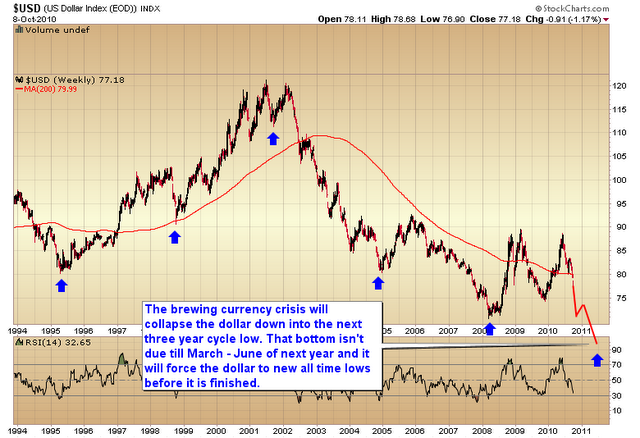
About every 3 to 3 1/2 years the dollar drops down into a major cycle low. I call it the 3 year cycle low but the average duration is 3 years and 3 months trough to trough. The dollar is now on its way down into that major bottom. After a brief bounce off the `10 lows later this year I expect we will see the dollar roll over early next spring as the final plunge begins and the currency crisis reaches a climax.
Next let me show you a chart of the smaller daily cycle.
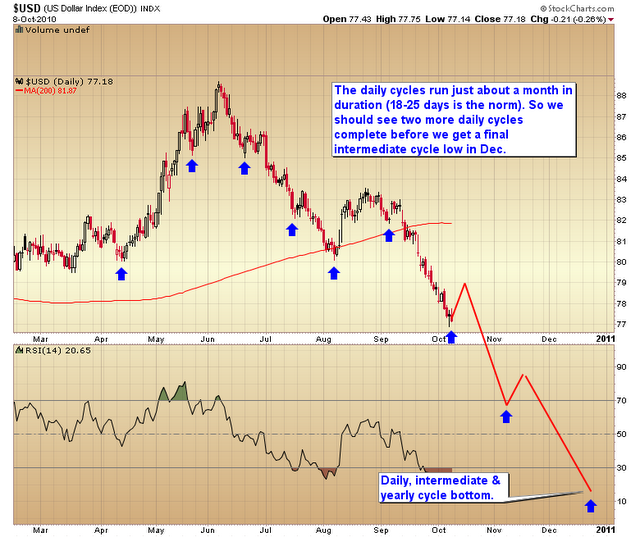
This smaller daily cycle tends to run about a month (18 to 25 days) trough to trough. We are now deep in the timing band for this cycle to bottom. Once it does (it may have on Thursday) we should see a weak rally, possibly back up to test the all important pivot at 80. That should pressure stocks and gold down into their respective cycle lows. I suspect many will take this as a sign that gold's run is over. It won't be.
Gold's drop into the now due cycle low shouldn't last more than 4-8 days. That's about how long we can expect the dollar rally to last as it will only be a dead cat bounce to relieve oversold conditions and ease sentiment extremes. Then the dollar will roll over into another decline that should bottom in early November and will likely test the 74 pivot. Again after another weak rally the dollar will crash down into a daily, intermediate and yearly cycle bottom that should test the `08 lows at 71. That is the point where the gold rally should take a more significant rest.
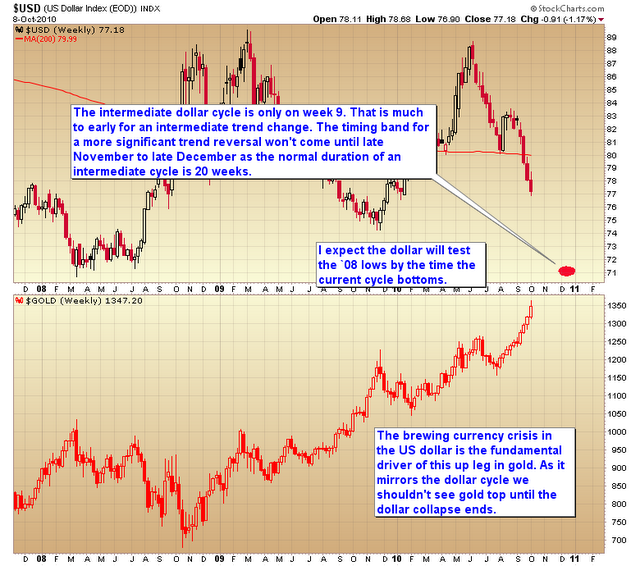
As I noted in the above chart the intermediate dollar, and gold cycle for that matter, runs on average 20 weeks. Last week marked the 9th week of the dollars intermediate cycle. It's way too early to look for a major bottom yet. If the cycle runs the "normal" 20 weeks then we won't get an intermediate bottom until late December. Considering the last yearly cycle low came in early December of `09, mid-December should be a fairly accurate target for an intermediate bottom.
I can assure you that while the dollar crisis intensifies this winter, gold will not be sitting still and it certainly won't be topping. As the dollar crashes down to test the `08 lows I expect we will see gold rocket to at least $1450 and $1550ish is probably a more realistic target.
But don't forget the larger three year cycle low isn't due to hit until next spring/summer. The dollar rally out of the yearly cycle low in December will also be a dead cat bounce, although it should last at least a month or two, but ultimately it too will fail and the true consequences of Bernanke's monetary policies will come home to roost as the dollar crashes down into the three year cycle bottom and the currency crisis reaches a climax next year.
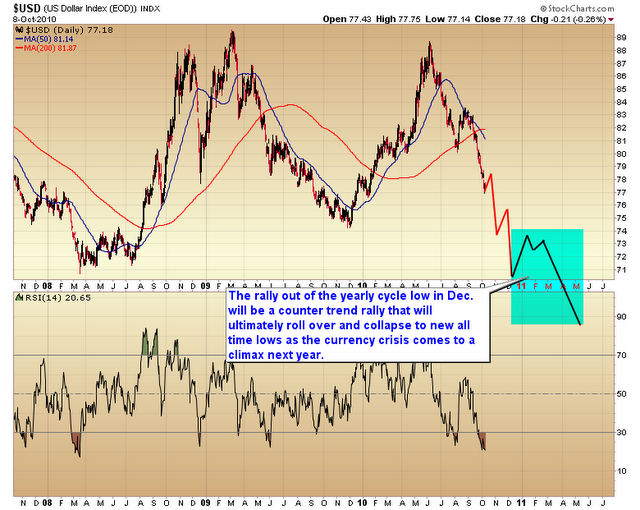
That will drive the final leg up in this huge C-wave advance, possibly as high as $1700 -$1800.
So yes gold is due for a minor corrective move but it is a long way from the final topping process of the current C-wave that began in April of last year when the B-wave decline tested 850 which, by the way, was the top of the 1980 bull market.
Folks we are never going to see $850 gold again. And I seriously doubt we will ever see $1200 gold for the remainder of this bull market.

China, with 10-times Japan's population, has long been expected to catch up with its neighbor. But the global crisis and Japan's sluggish growth brought that point forward by many years. China has emerged to become the world's largest exporter, overtaking Germany, which held the title since 2002. Factories employing low-paid workers to assemble iPods, computers, shoes, and toys are leading the boom. China has also passed the US as the world's largest auto market and producer. Two decades ago, a car industry barely existed in China.
In the midst of the global banking crisis, stimulus-driven Chinese growth helped to propel the world's economy out of recession. Chinese demand for raw materials and other imports buoyed economies from Australia to Brazil to South Korea. China uses more than half the world's iron ore and more than 40% of its steel, aluminum, and coal, lifting commodity prices. China is the biggest player in the copper market, buying 35% of the global supply, and is the second biggest importer of crude oil. State-owned Chinese companies are pouring billions of dollars into base metal mines and oil fields from Canada to Latin America to Iraq.
A free trade agreement between China and South East Asian nations came into effect on January 1st, creating the world's third-largest free trade bloc. The combined population of the trade bloc is 1.9-billion people with a combined GDP of $6-trillion. Already, the ASEAN countries are providing the raw materials and manufacturing parts for assembly hubs operating in China. About 60% of China-ASEAN made goods end up in European, Japanese, and US consumer markets.
China is at the epicenter of the fast growing Asian sphere, with satellites such as South Korea, Hong Kong, Taiwan, India, and Australia, hitching a ride to the Chinese juggernaut. The shift of economic gravity to China didn't happen by chance. Beijing's massive intervention transformed its economy into the world's locomotive. The state-run mouthpiece, the People's Daily newspaper has hailed China's economic superiority over Western-style capitalism, boasting about its authoritarian rulers' ability to make quick decisions and their will to carry them out.
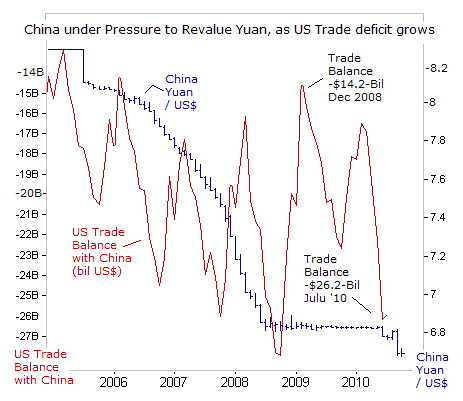
Washington is becoming increasingly alarmed at the rapid rise of China's economic might, and also worries that Beijing might eventually challenge the US for military superiority in the decades ahead. US Congressional lawmakers have long cited Beijing's policy of undervaluing its currency, - the yuan, to give its exporters an unfair advantage in world markets, and making China a more affordable place to attract foreign direct investment in new manufacturing plants. In July and August, the US ran a combined trade deficit of about $52-billion with China, with the massive imbalance highlighting the hollowing out of America's industrial base.
After holding the yuan steady against the US-dollar through the financial crisis, Beijing signaled on July 19th, that it would begin to allow for the yuan to drift higher, but at a gradual pace. Since then, the yuan has gained about +2.2%, - far short of what US lawmakers want. US Treasury chief Timothy Geithner told Congress on Sept 16th, "the pace of appreciation has been too slow and the extent of the yuan's appreciation too limited. We are examining the important question of what mix of tools, those available to the United States and multilateral approaches, might help encourage the Chinese authorities to move more quickly," he warned. IMF economists estimate the yuan is 5-27% undervalued.
As the US-economy continues to stagnate, lifting the all inclusive U-6 jobless rate to 17.1% of the workforce, the Obama administration and Congress are starting to wage an increasingly hostile war against China, demanding that Beijing allow the yuan to rise significantly, and at a faster rate. The US House of Representatives passed a bill on Sept 29th, with huge support of 348-79, that treats China's exchange rate as an unfair subsidy, and allows US companies to request a countervailing tariff to offset China's price advantage. Such legislation, if passed by the Senate, and signed by the President could ignite a full fledged protectionist trade war.
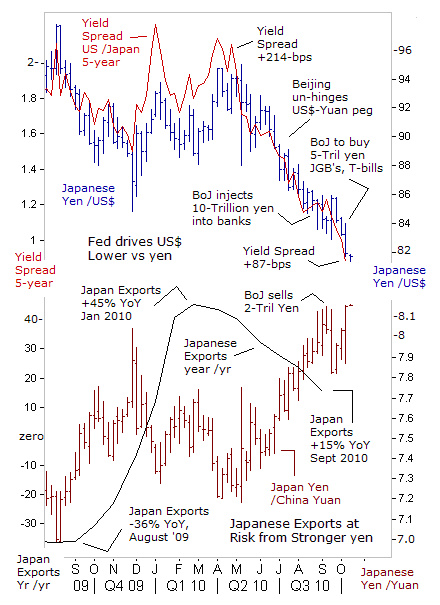
The US-Treasury and the Federal Reserve ("Plunge Protection Team") are seeking to corral central bankers and finance ministers from other G-20 nations, to join Obama's campaign to strong-arm Beijing into raising the value of the yuan more quickly. The US-Treasury is preparing an all-out "currency war," which has already started to inflate commodity and stock market bubbles, by instructing the Federal Reserve to send signals about a resumption of "quantitative easing" (QE-2) or the printing of dollars to purchase US Treasuries notes, in the months ahead.
The Fed is expected to pump vast quantities of freshly printed dollars into the money markets, in a bid to lower long-term Treasury yields lower. The markets have already discounted the probability of at least $500-billion of QE-2 injections. On the surface, the Fed's propaganda artists say they aim to prevent a deflationary collapse and stave off a "double-dip" recession. However, clandestinely, the Fed is monetizing the federal government's debt, and is prepared to buy the Treasury notes that Beijing decides to dump, should a full scale Chinese-US trade war erupt.
Discounting the probability of QE-2, the US-Treasury's bond yield advantage over comparable Japanese bonds, has narrowed sharply, thus weakening the US-dollar to a 15-year low of 81.75-yen. Tokyo has tried to offset the Fed's QE-2 gambit, saying it plans to launch its own version of QE-3, - a 5-trillion yen ($60-bil) scheme, designed to purchase Japanese government bonds (JGB's) and other securities.
On September 15th, Tokyo acted unilaterally, dumping some 2.1-trillion yen into the foreign currency market, for the first time in six-years, and purchasing of $25-biilion, while trying to defend the US-dollar at 83-yen. However, two-weeks later, the impact of the BoJ's "shock and awe," intervention scheme had worn-off, with the US-dollar sinking to new lows. Japan's counterattacks have failed to reverse the US-dollar's slide against the yen, because the size of the Fed's QE-2 printing spree is expected to be at least ten-times greater magnitude than Tokyo's QE-3.
And because Beijing essentially pegs the yuan to the US-dollar, Japan's exporters are getting slapped with a double whammy, a rising yen versus the US-dollar, and a rising yen versus the Chinese yuan. Since early May, the yen has risen +10% to around 8.2-yuan, making Japanese goods more expensive in China, and also in neighboring Hong Kong, where the central bank pegs the US$ at around HK$7.78.

Tokyo's financial warlords are very worried about the yen's strength, since the growth rate of Japan's exports have already slowed by two-thirds, from +45% at the start of this year, to +15% in August. Japan's exports are also becoming less competitive than those from Asian tiger - Taiwan, where the central bank enforces a "dirty float," by restricting the US-dollar to a narrow 10% trading band versus the Taiwan dollar. If left unchecked, the yen's upward spiral against rigged Asian currencies, and the US$, could push Japan's export growth into negative territory by next year.
Taiwan's exports account for roughly 70% of its economic output, and trade data for September showed the growth rate for its exports slowing to +17.5%, down from +26.6% in August. A slowdown in the growth of shipments to the Chinese mainland, where many goods are processed and re-exported, fell from +18.1% in August to +11% in September. All of this suggests Taiwan's authorities will not back down from its efforts to slow the US-dollar's fall, against the Taiwan dollar.
Taiwan's foreign currency reserves jumped $8.4-billion in September, a monthly record, and by about $21-billion in the past 3-½-months. In the first 10-days of October, the Taiwanese central bank bought US$3-billion to prevent it from falling below its red-line in the sand at 30.5-Taiwan dollars, the bottom of a decade long trading range. Through its stealth intervention over the past few years, Taiwan has amassed a huge stash of $380-billion in foreign currency reserves. Yet shockingly, only 4.3% of Taiwan's FX stash is invested in the king of currencies - Gold.
The US Treasury and the Obama team have allowed currency intervention culprits, such as Hong Kong's Monetary Authority (HKMA) and Taiwan, to slip under the radar, and instead, have chosen to focus more exclusively on Beijing's rigging of the yuan. However, the smaller Asian culprits might be next in-line. In any event, Washington is trying to gain the firm backing of the world's second most powerful trading bloc, the Euro-zone, which is also the biggest buyer of Chinese exports, in order to prod Beijing to allow the yuan to rise more rapidly.
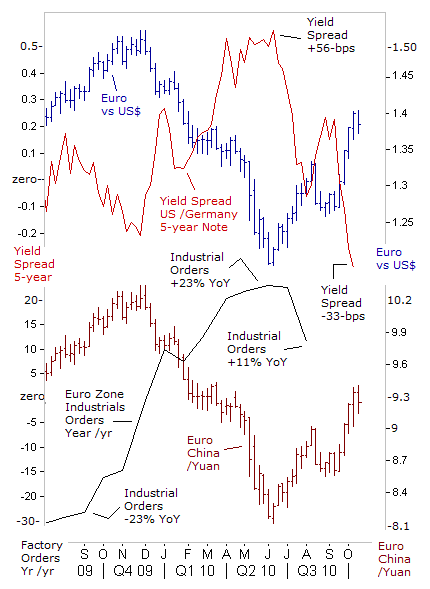
In some ways, the Greek debt crisis was a blessing in disguise for the Euro-zone's economy. The Euro's slide to a four-year low of $1.200, and a nine-year low against the Japanese yen, helped to boost new orders for industrial goods made in the Euro-zone to +23% higher in May than a year earlier. Germany in particular thrived on a weaker Euro, with surging exports and growth in consumer spending, powering the German economy to a record expansion in the second quarter. German exports were bolstered by demand from China and other emerging economies.
The Euro was plunging in a downward spiral in late April and early May, amid fears that the European Central Bank would unleash its own version of QE, by purchasing large quantities of Greek, Irish, and Portuguese bonds that Euro-zone banks were desperately looking to unload. So far however, the ECB has limited its purchases of distressed sovereign bonds to 60-billion Euros, and these purchases were largely sterilized, thus helping the Euro to rebound to $1.400 last week.
Also helping the Euro to rebound sharply versus the US$, was the frequent drumbeat of implied threats by the Fed to unleash QE-2, and public calls of support for the Euro by China's premier Wen Jiaboa. "I have repeatedly expressed China's support for a stable Euro and said that we will not reduce the amount of European bonds that we hold. We have stood by the EU's efforts to overcome its difficulties and achieve recovery," Wen said on Oct 3rd, seeking to curry favor with Euro-zone politicians. Wen also promised that Beijing would buy Greek bonds next year.
However, because Beijing pegs the yuan to the US-dollar, the Euro has climbed about 10% against the Chinese yuan over the past four months, and partly as a result, new orders for Euro-zone industrial goods quickly tapered-off. New orders for industrial goods fell -2.4% in July, slumping to a +11.2% year-on-year rise. Orders for capital goods, which are used in investment, fell -5.1% on the month and demand for durable consumer goods dropped -3.2-percent. Euro-zone exports were +18% higher in July than in the same period of 2009, and while still impressive, were down sharply from June's annual growth rate of +27-percent.
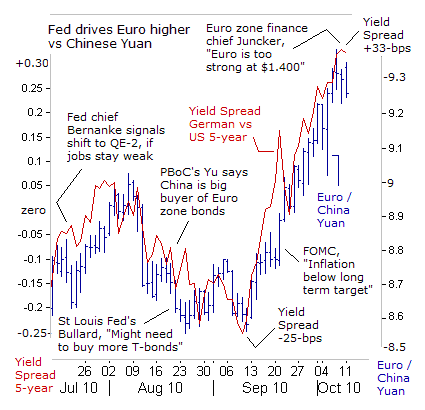
A further rise in the Euro's value against the Chinese yuan and the US-dollar could further undermine global demand for the Euro-zone's industrial exports, which prompted the Euro-zone's finance chief Jean-Claude Juncker to warn on October 8th, "The Euro is too strong today," as it crossed $1.400, and just a few hours ahead of a meeting of finance ministers and central bankers of the G-7 clique. "I don't think the US-dollar is in line with underlying fundamentals," Juncker said.
At a meeting with Chinese Prime Minister Wen Jiabao, ECB chief Jean "Tricky" Trichet, Jean-Claude Juncker, and the EU's Monetary Affairs chief Olli Rehn, called for "a significant and broad-based appreciation" of the Chinese yuan, to at least match the Euro's rebound against the US-dollar. Yet at the same time, the Euro-zone leaders praised China's commitment to purchase debt issued by troubled Greece, a measure that would boost the Euro vs the yuan.
Behind the scenes, the Fed engineered the Euro's recovery by submerging the yield on the US-Treasury's 5-year note below Germany's 5-year bund yields. So far, the ECB has refused to intervene to halt the Euro's rally. The ECB is skeptical in principle of interventions, - buying and selling currencies to affect exchange rates. However, if the Fed signals a larger than expected blast of QE-2 in November, the Euro could climb higher, and complaints from Euro-zone industrialists would follow. At that point, the ECB might cast aside its principles, and begin printing Euros and start buying bonds denominated in foreign currencies.
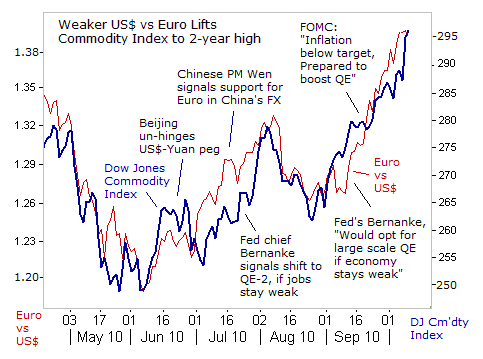
QE-2 fuels Commodities Rally, Since July 21st, Fed chief Ben "Bubbles" Bernanke has floated trial balloons about the unveiling of QE-2, and engineered a sharp fall in the US-dollar against the Euro, Japanese yen, Swiss franc, and emerging currencies. The weaker dollar has fueled "hot money" flows into emerging stock markets, lifted gold to record heights at $1,365 /oz, fueled silver's parabolic rally to 30-year highs, and global commodity indexes have climbed to two year highs.
On Sept 21st, the Fed made it clear that given the US-labor markets' weakness, it's determined to prevent a deflationary spiral. That's a widespread drop in wages, prices of goods and services, stock portfolios, and the value of homes. Under a cloak of deceit and deception, the Fed is reviving the animal spirits among speculators, and whetting the appetite for risk taking, by driving interest rates to historic lows and crushing the value of the US-dollar. The Fed's gambit is succeeding! Traders are now bidding-up commodities, shares of commodity producers, and precious metals, before the next tidal wave of QE-2 floods world money markets.
Soybeans jumped to $11.78 /bushel in Chicago, up +7% this month. Corn prices saw their biggest two-day rise since 1973, up 12.7% to $5.75 /bushel, as expectations of a drastic shortfall in crop production raised fears of a repeat of the global food crisis of 2007-2008. Already there's talk of the necessity rationing corn next year. Coffee and cotton have surged to their highest levels in 15-years, and in Shanghai, rubber futures rallied by their daily limit to their highest in four-years.
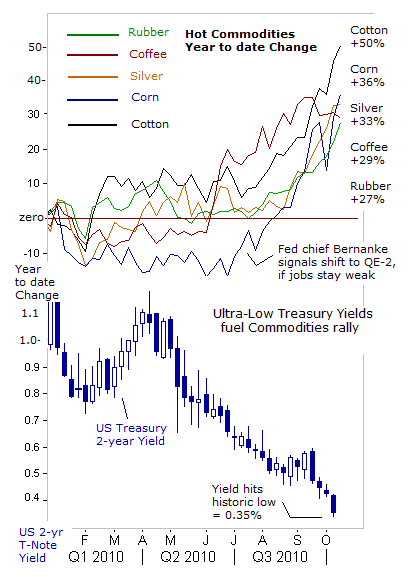
London copper rallied to around $8,400 /ton, its highest since July 2008, and aluminum extended a rally to touch $2,438,/ton. Shanghai zinc soared 5% to its upside limit of 18,875 yuan /ton, and US light crude oil topped $83 /barrel, as the US-dollar weakened against the Euro. So while Americans are losing their jobs and their homes, the Fed is making matters worse, by inflating the cost of the basic staples of life. Another key driver behind the resurgence of the "Commodity Super Cycle" is the slide in the US Treasury's 2-year yield to historic lows of 0.35% this week, essentially ruling out any hike in the fed funds rate until 2012.
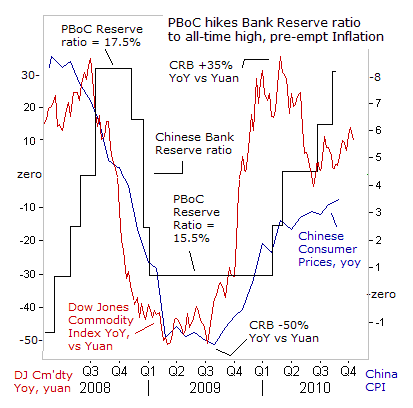
Food and energy account for about half of the budgetary outlays for the population in China and India that live on less than $2 /day. Thus, the central banks in the world's top-2 fastest growing economies are more willing to tighten monetary policy in order to combat inflationary pressures from higher commodity prices. According to Beijing's apparatchiks, China's consumer price index (CPI) was creeping +3.4% higher in August from a year ago. But China's CPI could be galloping ahead at a +5% clip or more, if global commodity markets continue to soar.
On October 11th, the People's Bank of China (PBoC) tried trying to deflate a powerful bubble in global commodity prices, and asset price inflation, by mopping-up excess yuan in the Shanghai money markets. The PBoC hiked reserve requirements for China's six largest banks, by a half-point to 17.5%, tying the highest level in history. Earlier this year, in January, global commodity and stock markets fell sharply after China surprised the traders by hiking reserve requirements a half-point to 16-percent. But on this latest occasion, traders simply yawned.
This time around, the PBoC's tightening moves have been neutralized by the Fed's plan to unleash $500-billion or more of QE-2. The Fed and the US Treasury are threatening to take the inflationary effects of super-easy money to the extreme limit, even though QE-2 won't bring down the US-jobless rate. Instead, the impact of QE-2 could be felt more acutely in China and India with sharply higher commodity prices, and perhaps, followed by tighter monetary policies. At some point, Beijing might see the logic of allowing the yuan to rise faster against the dollar, utilized as a tool to help keep the imported price of commodities under control.

In both Japan and the United States, short-term interest rates are so close to zero-percent that their central banks have resorted to nuclear QE in a bid to drive down long-term bond yields. But these radical measures have failed to boost economic growth. With fiscal stimulus packages being pared down, in order to rein-in bloated budget deficits, and zero-percent interest rates failing to produce jobs, politicians are seeking to expand exports, by reducing the value of their currencies, as the sole remaining measure available to provide an economic boost.
Warning of the danger of currency wars, IMF Managing Director Dominique Strauss-Kahn told finance chiefs of the G-7 industrial powers and the emerging economies of Asia and Latin America, "There is clearly the idea beginning to circulate that currencies can be used as a policy weapon. Translated into action, such an idea would represent a very serious risk to the global recovery." Yet the global currency system itself, and the entire network of economic relations built upon foreign trade, - is already breaking down under the weight of QE- in England, Japan, and the US, and the daily rigging of currencies in the emerging world.
Through stealth intervention in the foreign exchange market, Japan's central bank has accumulated the world's second largest stash of FX reserves, reaching $1.1-trilion in September. The size of Japan's FX has also swelled reflecting the inflated value of its holdings of European and US-Treasury bonds. Last moth, the BoJ held 765-tons of gold in its vaults, equal to only 2.7% of its FX reserves. Gold dealers have long recognized that at some point, Tokyo would eventually end its folly of accumulating paper currencies, and instead, would see the logic of switching more of its bloated FX stash into hard assets, such as gold or silver.
In an interesting move last week, Japan's ruling Democratic Party proposed taking advantage of a strong yen to invest part of Japan's $1.1-trillion stash into securing natural resources in overseas markets, thus raising the stakes in a global battle with Beijing for strategic assets. Thus, the global "currency wars," revolving around the Chinese yuan, can resurrect the "Commodity Super Cycle," and establish Gold as the key medium of exchange that can guarantee banks' promises to pay depositors, promises to redeem note holders, or to secure faith in a currency.